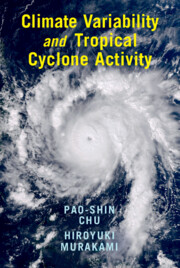Book contents
- Climate Variability and Tropical Cyclone Activity
- Climate Variability and Tropical Cyclone Activity
- Copyright page
- Contents
- Preface
- Abbreviations
- 1 Introduction
- 2 Climate Variability. Part I: Intraseasonal Oscillation
- 3 Climate Variability. Part II: Interannual to Interdecadal Variability
- 4 Climate Variability and Tropical Cyclones
- 5 Subseasonal to Seasonal Tropical Cyclone Prediction
- 6 Extreme Typhoon Rainfall Under Changing Climate
- 7 Future Tropical Cyclone Projections and Uncertainty Estimates
- Index
- References
7 - Future Tropical Cyclone Projections and Uncertainty Estimates
Published online by Cambridge University Press: 17 February 2022
- Climate Variability and Tropical Cyclone Activity
- Climate Variability and Tropical Cyclone Activity
- Copyright page
- Contents
- Preface
- Abbreviations
- 1 Introduction
- 2 Climate Variability. Part I: Intraseasonal Oscillation
- 3 Climate Variability. Part II: Interannual to Interdecadal Variability
- 4 Climate Variability and Tropical Cyclones
- 5 Subseasonal to Seasonal Tropical Cyclone Prediction
- 6 Extreme Typhoon Rainfall Under Changing Climate
- 7 Future Tropical Cyclone Projections and Uncertainty Estimates
- Index
- References
Summary
Tropical cyclones exert great impact on society. Therefore, for a long time an important scientific question has been whether changing the climate system affects tropical cyclone activity. Recent studies reported that global mean temperature has been rising since the mid-twentieth century, and the temperature rise is attributable to increases in emissions of greenhouse gasses (Bindoff et al., 2013; IPCC, 2013). An intuitive hypothesis under the warming trend at a global scale is that the mean global number of tropical cyclones would increase and mean storm intensity would be stronger because tropical cyclone activity could be favorable in a warmer environment. However, the science community has not yet reached a robust consensus on whether this hypothesis is true or not, especially for the effect of global warming on global tropical cyclone numbers (IPCC, 2013).
- Type
- Chapter
- Information
- Climate Variability and Tropical Cyclone Activity , pp. 258 - 292Publisher: Cambridge University PressPrint publication year: 2022



